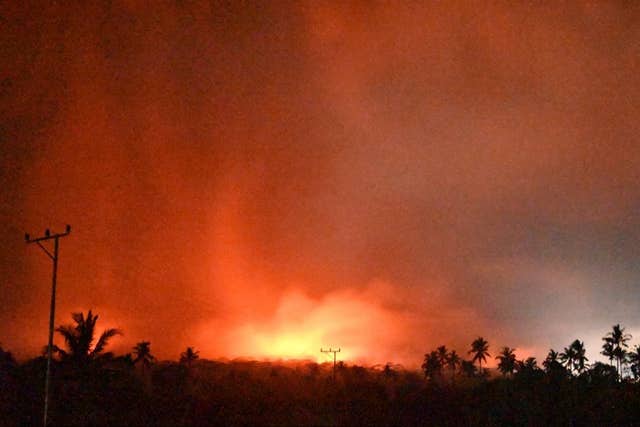At least 10 people have died as a series of volcanic eruptions widens on the remote Indonesian island of Flores, the country’s National Disaster Management Agency said.
The eruption at Mount Lewotobi Laki Laki just after midnight on Monday spewed thick brownish ash as high as 2,000 metres (6,500 feet) into the air and hot ashes hit a nearby village, burning down several houses including a convent of Catholic nuns, said Firman Yosef, an official at the Mount Lewotobi Laki Laki monitoring post.
Rescuers are still searching for more bodies buried under collapsed houses, said Abdul Muhari, the National Disaster Management Agency’s spokesperson. Mr Muhari said all the bodies, including a child, were found with a 2.4 mile radius of the crater.
He said at least 10,000 people have been affected by the eruption in six villages of Wulanggitang District, and four villages in Ile Bura district. Some have fled to relatives’ houses while the local government is readying schools to use as temporary shelters.
Authorities also raised the danger level and widened the danger zone for Mount Lewotobi Laki Laki on Monday, following a series of eruptions that began last week.

The country’s volcano monitoring agency increased the volcano’s alert status to the highest level and more than doubled the exclusion zone to a seven-kilometre (4.3-mile) radius after midnight on Monday as eruptions became more frequent.
The agency said at least 10,000 people have been affected by the eruption in Wulanggitang District, in the six nearby villages of Pululera, Nawokote, Hokeng Jaya, Klatanlo, Boru and Boru Kedang.
In Ile Bura District, four villages were affected – Dulipali Village, Nobo, Nurabelen and Riang Rita – while in Titehena District it affected four villages – Konga Village, Kobasoma, Bokang Wolomatang and Watowara.
Authorities said volcanic material was thrown up to six kilometres (3.7 miles) from its crater, blanketing nearby villages and towns with tonnes of volcanic debris and forcing residents to flee.
A nun in Hokeng village died and another was missing, said Agusta Palma, the head of the Saint Gabriel Foundation that oversees convents on the majority-Catholic island.
Photos and videos circulated on social media showed tonnes of volcanic debris covering houses up to their rooftops in villages like Hokeng, where hot volcanic material set fire to houses.
It is Indonesia’s second volcanic eruption in as many weeks. West Sumatra province’s Mount Marapi, one of the country’s most active volcanos, erupted on October 27, spewing thick columns of ash at least three times and blanketing nearby villages with debris, but no casualties were reported.




House Rules
We do not moderate comments, but we expect readers to adhere to certain rules in the interests of open and accountable debate.
Read the rules hereLast Updated:
Report this comment Cancel